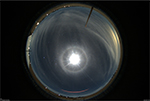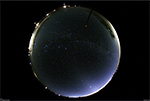 |
 |
 |
 |
| Earth's shadow at sunset April 6, 2013 |
Late
August early evening overhead Milky Way |
Achernar culminating on the Southern Horizon 4 November 2005, 11:20
pm MST; Altitude 1 deg, Azimuth 182 deg; Magnitude 0.54 |
Achernar culminating on the Southern Horizon December 10, 2014 at 8:45 pm MST |
| |
|
|
|
 |
 |
 |
 |
| Gacrux (the top star in the Southern Cross)
culminating on the Southern Horizon 18 May 2007 9:40 pm MST;
Altitude 0.5 deg, Azimuth 184 deg; Magnitude 1.65 |
Space alien? Probably Western Meadowlark sitting on All Sky Camera |
All Sky Camera view of Sun's rays shining through clouds |
Another space alien? Probably an owl sitting on the All Sky Camera |
| |
|
|
|
 |
 |
 |
 |
| Sun halo on January 18, 2016 at 11:51 am MST |
Moon halo on January 18, 2016 at 8:46 pm MST |
Moon halo on January 19, 2016 at 8:11 pm MST |
Winter Milky Way the Zodiacal Light on February 29, 2016 |
| |
|
|
|
 |
 |
 |
 |
| Moon halo on January 4, 2017 at 7:56 pm MST |
Moon halo on February 3, 2017 at 7:21 pm MST |
Sun halo on June 15, 2018 |
Perseid meteor August 12, 2018 |
| |
|
|
|
 |
 |
|
|
| Moon halo on January 12, 2002 at 9:20 pm MST |
The Zodiacal Light on January 18, 2022 |
|
|
| |
|
|
|
The Grasslands Observatory is owned by Tim
Hunter. The Director of the observatory is James McGaha. The observatory was started
in 1985 when Tim
Hunter purchased 20 acres of land at a remote location in Southeastern Arizona approximately an hour's drive
from Tucson. The site has no horizon obstructions in any
direction and sits on a large grassy plateau surrounded by
distant mountains. It is at 5000 feet elevation, and there is
only minor/moderate light pollution from distant Tucson, Sierra Vista,
and Nogales, Arizona (and Sonora, Mexico).
In 1986, a 24-inch f/5 equatorial Newtonian (f/20 Cassegrain telescope) was purchased
from its builder Jeff Shaffer and installed in a 20 x 20 foot
roll-off building. The Original Observatory Building was designed by Tim Hunter and
James McGaha and built by them under the guidance of Jeff
Shaffer. James McGaha coordinated the moving and installation of
the telescope in its new facility.
The Original Observatory Building consists of a 20 x 20
foot roll-off roof structure housing the fork mounted 24-inch f/5
Newtonian reflector. To the direct west of the old Observatory Building is
the Warm Room (also known as the Control Room), a separate building which is
heated and insulated. It contains the controls for the original 24-inch telescope
and also has a microwave, refrigerator, computers, a bed, power, and telephone. Unfortunately, there is no running
water.
Since 1995, the original 24-inch f/5 telescope and its associated instruments as well as new telescopes in new observatory buildings have
been operated from the Warm Room/Control Room. The Warm Room was built in 1995 when the
original 24-inch telescope was changed from mainly visual use to electronic
imaging at the Newtonian f/5 focus.
The Warm Room (also sometimes called the Control Room) was originally a small,
14 x 14 foot one-room well insulated house with lights, heat!!, a
refrigerator, microwave, futon, chairs, and a Control Console for operating the original 24-inch telescope. The Control Console even today remains connected by
cables running through a metal conduit to the Original Observatory
Building. Now the Control Console is also connected to three other separate observatory buildings (ASA 20-inch Building; PlaneWave CKD24 Building; Takahashi Epsilon 180 Building) by CAT6 ethernet cables to control computers in each of those buildings.
In late 2013 and early 2014, the Warm Room/Control Room was significantly expanded to the west so that it now measures 14 x 26 feet (outside dimensions). The windows were removed, and the door situated to the south out of the path of the main wind direction. A heavy duty door with a heavy duty screen was installed.
Added to the expanded Warm Room is a large separate Storage Room for infrequently used tools and spare equipment. Most of the large accumulated tools and equipment (such as fence post driver, fence posts, pickaxe, spare wood beams, and tarps) were removed from the old Observatory Building and placed in the Storage Room vastly improving the look and cleanliness in the old Observatory Building itself. A new weather station and an All Sky Cam were also added.
The Observatory has had reliable internet service since the summer of 2015. This is provided by TransWorld Network Corp (TWN) using its Wi-Power Business Connect. In order to obtain a signal from the TWN transmitter sitting more than 20 miles to west on a small mountain, it was necessary to have Sulpher Springs Valley Electric Cooperative, Inc (SSVEC) install a 45-foot power pole. A Wi-Power antenna was then placed about 30 feet off the ground, high enough to clear a small ridge line to the west and high enough to receive a strong signal from the Wi-Power transmitter.
The three new 14 x 14 foot roll-off roof observatory buildings lie to the south and somewhat west of the Original Observatory Building and the Warm Room. The eastern most of these is Buiding 1 which contains an ASA 20-inch f/3.6 astrograph which went into operation in early November 2017 and is controlled remotely. It is used with an FLI Proline 9000 CCD and FLI CFW5-7 filter wheel with a clear filter and photometric R, V, and B, filters, and a hydrogen alpha filter.
Building 2 is the center 14 x 14 foot roll-off roof observatory building. It contains a PlaneWave CDK24 24-inch f/6.5 telescope with an FLI Proline 9000 CCD and FLI CFW5-7 filter wheel having a clear filter, a hydrogen alpha filter, and photometric R, V, and B filters. This telescope is in operation and is controlled remotedly.
Building 3 is the western most 14 x 14 foot roll-off roof observatory building. It contains a Takahashi Epsilon 180 f/2.8 telescope with a Canon EOS Ra single shot color camera. This telescope came on line in late April 2019 and currently is in operation and is controlled remotely.
Ancillary equipment includes an 8-inch f/4 Meade LXD75 Schmidt-Newtonian telescope which has been mounted onto the side
of the original 24-inch telescope. Imaging through the 8-inch telescope
is done with a Canon 20Da or 60Da digital camera back.
In January 2022 an ALCOR Aphea 6 CW all sky camera was added to the observatory. This gives 180 x 180 degree all sky views both day an night. It contains a ZWO imaging camera with a 3100 x 2100 pixel dimension chip having 5.4 arcminutes per pixel. Images posted on this website are typically reduced to a 1200-1400 pixel width for easier web display.
Imaging at the Grasslands Observatory
From 1987 until approximately 1995 film was used for all astrophotography. Some of the early film images are still on the website (see photographic Messier Marathon). From 1995 onward only digital imaging has been performed. The main workhorse digital cameras until 2014 were the Apogee AP7 and the Fingers Lake
Instrumentation Dream Machine CCD on the original 24-inch telescope using its Newtonian focus at f/5.
Many of the images from the AP7 or Dream Machine remain on this website. Quite a few of the images are mediocre, more due to poor imaging conditions or poor processing of the images rather than any limitations with the equipment. Some of the images from the AP7 and Dream Machine are quite good and difficult to improve upon using the new CCD's and telescopes now availabe at the Observatory.
The Apogee AP7
CCD camera was used until September 2000. It had a very
sensitive SITe 512 x 512 chip with 24 micron pixels. It was
attached to an ISIS
FW1 filter wheel containing an open slot, a clear filter,
and standard R, V, B, and I (near-infrared) photometric filters. Among its
accomplishments was the obtaining of black and whites images for all 338 Arp Galaxies and
tri-color imaging of all the Messier
Objects. In September 2000, the AP7 camera was replaced by the Dream Machine which was in operation until late 2014.
The majority of the images presently on this website were obtained with the Dream Machine
combined with a Finger Lakes CFW-1 Color Filter Wheel using
photometric R, V, and B filters as well as a clear (C) parfocal filter. The AP7 gave a field of view of
14 minutes. The Dream Machine has a chip with a similar
quantum efficiency as the AP7, but the chip is twice as large
(1024 x 1024) and gave a nearly 28 minute field of view with the 24-inch f/5 telescope.
Prior to the AP7, an
HPC-1 camera had been used, and a few of its images are still
posted on this website. The HPC-1 was a very fine camera with 12
micron pixels and a 1024 x 1024 pixel array. Its quantum
efficiency was good in the red and green portions of the
spectrum, but it had a relatively low quantum efficiency in the
blue portion of the spectrum.
At the present time all imaging is done remotely using the PlaneWave CDK24 24-inch f/6.5 telescope and FLI Proline 9000 CCD, the ASA 20-inch f/3.5 astrograph and FLI Proline 9000 CCD, or a Takahasi Epsilon 180 f/2.8 telescope with a Canon EOS Ra camera.
Almost all of the images on this website are displayed with the north to the top
and east to the left, standard astronomical orientation. This is to provide consistency in image display and orientation from object to object and from year to year.
|
